By John Shand, Cassie Tongue, Peter McCallum, Shamim Razavi and Penry Buckley
THE QUEEN’S NANNY
Ensemble Theatre, September 10
Until October 12
Reviewed by JOHN SHAND
★★★
The last five minutes pin your ears back, leaving you wondering why more of the play didn’t bristle with this intensity, this sense of lives being defined or wasted. Perhaps the curious detachment we feel for most of the 90 minutes may be attributed to mixed intentions on playwright Melanie Tait’s part, veering from satire to weightier emotions.
Based on true events, The Queen’s Nanny, here having its world premiere, tells of Marion Crawford, whom Elizabeth (Duchess of York, later the late Queen Mother) appointed as nanny of her young daughters Elizabeth (later the Queen) and Margaret, a position “Crawfie” (as she was affectionately known) held for 17 years from 1933.
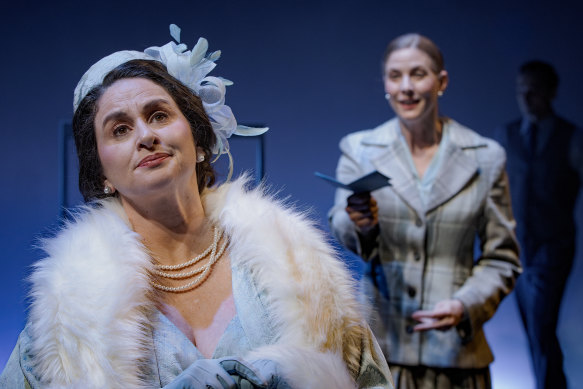
Emma Palmer as Elizabeth and Elizabeth Blackmore as Crawfie. Credit: Phil Erbacher
Tait specifies her play be performed by just three actors, and in Priscilla Jackman’s spare production, Elizabeth Blackmore is Crawfie, Emma Palmer is Elizabeth, and Matthew Backer plays everyone else, including a narrator, the king, a butler, Crawfie’s eventual husband and, most prominently, Princess Elizabeth, or Lilibet.
Much of the play is an elaborate satire, albeit an affectionate rather than merciless one. Nonetheless, satires innately keep us at arm’s length, laughing at the characters rather than with them. The key exception is Crawfie herself, who sacrifices her child-bearing years to the care of the princesses and then becomes estranged from the future Queen whom she raised as her own.
This is partly because Crawfie became the first in a long line of royal servants to publish a tell-all memoir, The Little Princesses, which infuriated the snooty Queen Mother. She feared the whole monarchy might come crashing down as a result – the specific danger being that people would find out how mundane they were.
The structural problem is that by the time Crawfie, the only character capable of winning our hearts, has done so, the play is ending. This is no fault of Blackmore’s performance.
With her erect carriage, demureness and lilting Scottish accent, she gives us a warmly credible Crawfie from the outset, conveying self-effacing intelligence and the expert child-rearing she bestowed upon her charges (who saw little of their parents). More than that, Blackmore wordlessly expresses Crawfie’s inner world of reveries via such a dreamy expression in her eyes as transports her and us far from the confines of the stage.
Emma Palmer is a hoot as Lilibet’s overbearing, over-drinking mother, but the role is inherently caricatured. Regardless of what history may tell us, the play would be much more compelling if we could feel some sympathy for her abhorrence of Crawfie’s book as a gross betrayal. Instead, we tend to laugh.
Backer is wondrously chameleonic as he flits (with barely a costume change) between his half-dozen characters, his body metamorphosing with each new voice, most notably the initially angelic Lilibet, whom he depicts across 55 years of her life. But the flitting is mostly between surfaces, as Tait gives Backer little psychological depth.
Jackman directs the production with technical assurance, having hit upon a delightful scenic vocabulary with designer Michael Hankin that involves minimal, slightly surreal furniture, dolls’ houses, and even a model train.
Much more than merely accomplished, Tait’s storytelling can be invigorating in its propulsive use of narration, and its bursts of lyricism, but the play remains a light comedy when something deeper is beckoning. The jangling confluence of bitterness, disloyalty and disappointment that mires us at the end could have entrapped us across more of the work – although those who find the royals innately fascinating may be more consistently engaged.
KAREN GOMYO
Sydney Symphony Orchestra
Opera House Concert Hall. September 14
Reviewed by PETER McCALLUM
★★★★
Karen Gomyo played the soloist’s first phrase in Dvorak’s Violin Concerto in A minor, Opus 53, with an arresting strength of gesture, following on with a sweet subtle sound that blended with the accompanying woodwind instruments like sunlight catching a stream.
She articulated the virtuosity of the first movement with forceful clarity and an instinct for just, incisive rhythm, the octaves and fiery passagework always impeccably tuned. Although a highly virtuosic work, the solo part is carefully woven into the orchestral fabric, which may have been one reason why the work’s original dedicatee, the violinist Joseph Joachim, suggested Dvorak thin out the orchestral texture (he didn’t).
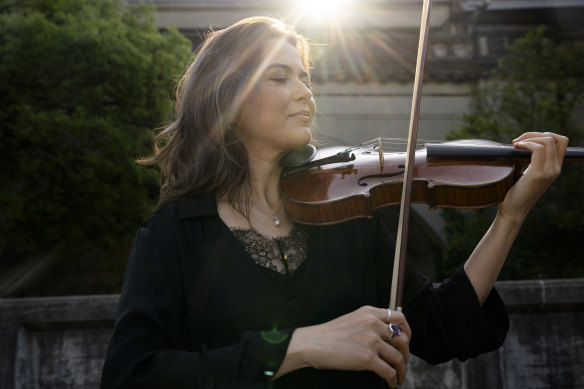
Karen Gomyo’s opening phrase was like sunlight catching a stream.Credit: Janie Barrett
The Sydney Symphony Orchestra players and conductor Daniel Carter were well attuned to potential problems in this regard, emphasising glowing balance that allowed Gomyo’s sound to glisten through subtly. Dvorak launches into the slow movement of this concerto just after the recapitulation of the first has started as though to say “you have heard all that – now for something different”.
Gomyo gave us something different, playing the theme with mellow quiet warmth, the expressiveness inward and not overdone. It was in the playfully syncopated finale that she seized the momentum boldly, leading the dance with dynamic energy and strong rhythmic definition. Carter listened closely to Gomyo’s nuance, finishing off phrases like the end of the slow movement with tapered polish and intensifying the incendiary rise in excitement in the finale’s coda with sensitive alertness.
In the second half, Carter showed an appreciation for the scope of the expressive canvas of Rachmaninov’s Symphony No. 2 in E minor, Opus 27, shaping the brooding opening idea carefully and giving weighty breadth to the richly thickened string sound as the introduction reaches a climax.
Alexandre Oguey’s plaintive oboe solo provided a moment of lonely stillness before the theme of the Allegro moderato, which itself picks up on the idea of the opening as though to provide a discursive explanation of what that opening brooding was hinting at.
In the scherzo, the interaction of strings and horns had memorably brisk vigour after which Francesco Celata played the clarinet solo of the third movement with nuanced quietness. Except for the small reminiscences of earlier movements that Rachmaninov inserts, all of this was swept away in headlong forward movement of the finale.
The clarity of Carter’s direction and the high professionalism of the SSO players joined to create a taut, closely engaged listening experience that erupted in cheers at the final barline.
LAUFEY
Opera House Concert Hall, September 13
Reviewed by PENRY BUCKLEY
★★★★
On the night-time approach to the Opera House, a red ribbon flashes out of the darkness. It’s followed by a host of others – pink, black, white – tied into hair, pinned to jackets and, in the case of one surly boyfriend, looped through a rat-tail.
These are the Lauvers, the fandom of Icelandic jazz-pop singer Laufey, gathering at the first of two sold-out Sydney shows for her second album Bewitched.

Laufey says she wants to do for jazz what Taylor Swift has done for country.Credit: Getty Images
The title is fitting: from the moment she emerges to While You Were Sleeping, the 25-year-old is in complete, charismatic control of her audience.
Laufey, who has said she wants to do for jazz what Taylor Swift has done for country, clearly has powers of persuasion. The audience grooves to a drum and bass interlude between Second Best and Dreamer, and to Falling Behind, with its reference to “Bossa nova in my room/Hope that I’ll find someone, too”.
Where Swift’s songs tend to cast an eye back on past relationships, Laufey’s dwell more in unfulfilled passion and romantic fantasy. (An anecdote about Beautiful Stranger, written about someone she saw “on the Tube”, elicits a ripple of delight.)
Later in the show, the classically trained multi-instrumentalist, who effortlessly switches from guitar to cello, moves to the piano for the Chopin-inspired Nocturne (Interlude).
The key to Laufey’s success is that she knows her Gen Z audience. As she told this masthead last year: “I understand how they work and how they act.”
A self-professed old soul, whose taste was formed by her Icelandic father’s jazz records and her Chinese mother and grandfather’s classical violin training, she is equally comfortable telling her young audience about the “situationship” she wrote Promise about – after all, in an era of obsessive fans, Lauvers are invested in her personal life.
This is further reflected in the reception to Laufey’s identical twin sister Junia coming on stage to play the violin solo in closing song, viral hit From the Start. (Laufey herself returns to rapturous applause for encore Letter to My 13 Year Old Self.)
And when the concertgoers, unprompted, light up the Concert Hall with their phones during the album’s title track, the connection is complete. “That was so cute,” Laufey says. “Needless to say, you’ve all bewitched me tonight.”
IRON MAIDEN
Qudos Bank Arena, 12 September
Reviewed by SHAMIM RAZAVI
★★★★
How many guitarists is too many, and is it really a solo if there are four of them working away at it together? Iron Maiden’s mastery on this night suggests they wouldn’t be one of the most influential bands of all time without the carefully weighed contribution of each musician. What looks like impenetrable anarchy is actually a careful, finely wrought tunefulness whose magic lies not in the noise but in the delicacy with which it is brought together, twiddles and all.
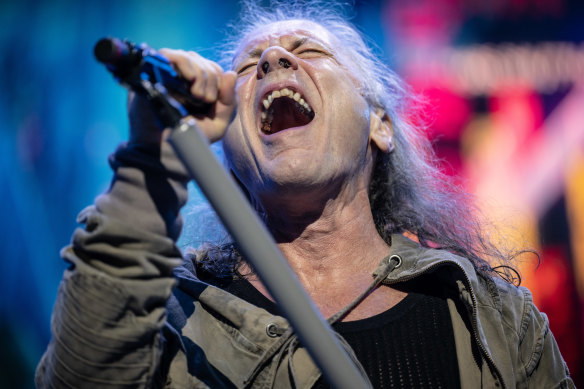
Bruce Dickinson brings the archetypal metal voice to the party.Credit: Wolter Peeters
If there is one element that stands out, it is Bruce Dickinson’s unmistakable tenor. His is the archetypal metal voice and when it is given the runway to take off – as it does in the final third of the set and in the encores – it brings the missing element to the classic Maiden sound. What has preceded would be a legendary show for many other bands, but from 2021’s Death of the Celts forwards we are treated to heavy metal perfection.
That perfection implies a masterclass in all the tropes of the genre – camp theatricality, gory dystopia, pyrotechnics and puppets – delivered by teachers who created much of the form.
Stylistically they retain a distinct Englishness, mining not only the iconography of English battles and banners but also the traditional folk melodies invoked in the jaunty lines beneath their layers of noise.
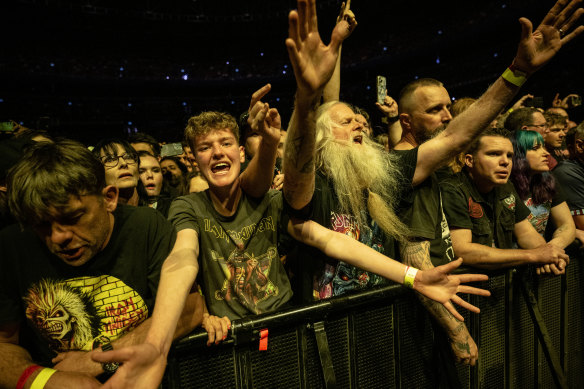
Eventually the mosh pit intensity takes over the entire stadium.Credit: Wolter Peeters
By the time Fear of the Dark and The Trooper are unleashed, the mosh pit intensity overtakes the entire arena, seats and all. Two hours of being played like an instrument in Dickinson’s hands will do that to an audience.
What holds the night back from perfection is a sound mix that isn’t quite on form, and the fact that there is, somewhere, a dream Iron Maiden set list comprising some of the greatest metal songs ever screamed. Perhaps that show is reserved for a victory lap final tour but, until then, this night’s is hard to top.
ALL BOYS
KXT on Broadway, September 11
Reviewed by Cassie Tongue
★★★★
Private all-boys schools – wealthy sites of elitism and entitlement that make future prime ministers and chief executives, haunted by whispers of violence and abuse – are, for better or worse, part of Sydney’s DNA.
All Boys, the play by Xavier Hazard making its Sydney premiere after appearing on the Griffin Award longlist (and a season at Perth’s Blue Room Theatre), feels like it’s landed exactly where it belongs. It tucks neatly and naturally into the tiny but ambitious KXT on Broadway, and as its cast of young men navigate the institutional perks, trials and toxicity of a top-tier, high-fee school, their voices echo so many just outside the theatre doors.
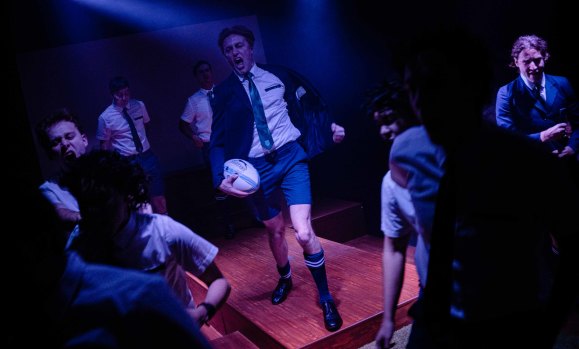
Robert Miniter (centre) as Josh in All Boys.Credit: Nicholas Warrand
Hazard’s deeply observational, gently moving and genuinely witty script builds on short, sharp scenes that drive its characters from year 7 through to graduation. There are boarders from country towns learning new rules, wealthy legacy students, and those on financial scholarships – and threats of assault, degradation and abuse.
The cast – all fresh from NIDA, many making stage debuts – is strong, instinctive and skilled (expect to see them on stage and screen again very soon). We watch the years roll by as the boys stare down their differences, desires, and ambitions – and grapple with the social cost of their choices.
Directed by Mehhma Malhi with clarity and care, the production is human-first, teasing out initial character sketches into thoughtful, three-dimensional studies that mostly resist shortcuts and stereotypes. Malhi shapes scenes, no matter how quick, to become the centre of the world (capturing that adolescent all-or-nothing drive).
She and her all-female creative team work in harmony with Hazard’s script to show how a society that wields masculinity as a weapon makes victims of boys as much as it does anyone who isn’t male. They do this by lingering on the damage – fraught silences, a crestfallen response, a defensive shrug.
While the play sits awkwardly at a two-hour runtime, introduces a hint of challenge to the system that comes too late and lands too softly, and a few emotional beats resolve without the rest of the play’s trademark nuance, the heart of All Boys is strong and sturdy. With a little reworking or restructuring to establish a smoother sense of escalation and emotional payoff, it could have a long life.
But even now, it’s an exciting glimpse, from playwright to creative team to cast, of new artists making their mark.
EUMERALLA, A WAR REQUIEM FOR PEACE
Sydney Symphony Orchestra
Opera House Concert Hall, September 11
Reviewed by Peter McCallum
★★★½
Eumeralla, A War Requiem for Peace by Deborah Cheetham Fraillon laments a war that many Australians haven’t heard of and seeks a peace most yearn for. The Eumeralla Wars were waged between the Gunditjmara people and colonial settlers from the 1830s to the 1860s in what is now south-west Victoria.
A Yorta Yorta woman, Cheetham Fraillon, along with linguists Vicki Couzens and Kris Eira, have created a text sung in the Gunditjmara language. This takes the Latin Requiem text, as known through canonical musical settings by Mozart, Verdi, Faure, and Britten, as a framework but expands its images and metaphors to incorporate Aboriginal spirituality.
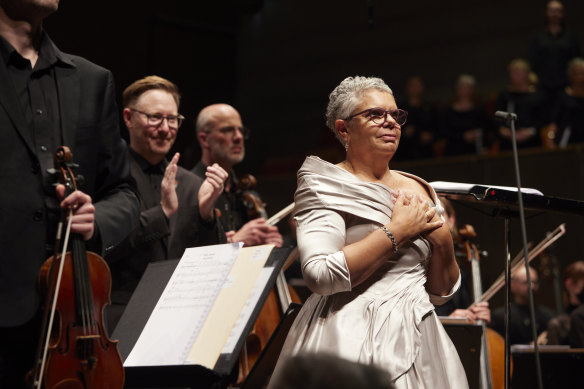
Conductor Benjamin Northey applauds composer and soloist Deborah Cheetham Fraillon at a 2023 performance in Melbourne.Credit: Laura Manariti
Blending soloists (soprano Cheetham Fraillon, mezzo-soprano Jess Hitchcock and baritone Jud Arthur), the Dhungala Children’s Choir, students of the Conservatorium High School, Sydney Philharmonia Choirs and the Sydney Symphony Orchestra conducted by Benjamin Northey, the work unfolds over 19 short movements. Some are gnomic and end abruptly; others, such as Sanctus and Benedictus, join together in longer spans.
As each movement was performed, striking artworks by Gunditjmara artist Tom Day were projected, representing the landscape on which he grew up and the stories of his people’s defiance and resilience. Day’s images provided the key to matching the requiem form to Gunditjmara culture and history.
The text and image for the first movement, Requiem, described Pernmeyyal the “great creator”, while the music introduced quiet clarinet and soprano solos with the choir in a mournful mood and minor key.
Dies Irae was darker and more agitated, and that mood was developed menacingly up until the fifth movement, Agnus Dei. Here, the mode changed to major, and soprano, baritone, and choir mixed austere textures with short, woven imitative passages. There was also a short fugal episode in Domine Jesu Christe (xiii), but in general, Cheetham Fraillon’s style is defined by melody around sustained chords and clear tonality, avoiding extensive chromaticism or development.
Motives often exploit the sixth and fifth scale degrees, plaintively in minor keys and serenely in major. Ideas tend to be stated and move on, and in some places, the expressive tone subverts traditional expectations. Thus, Libera Me was laced with anguish and stern fateful motives, while Rex Tremendae began with a quiet instrumental introduction and peacefully extolled “the earth in all its beauty”. Ricordare (“remember”) began with quiet flute solo and soprano and ended in decisive firmness bordering on anger.
Although the dominant tone was of mournful sorrow, there were also more dramatic movements, such as the tempestuous Confutatis (xi), and the clamorous Hostias (xiv) which praised Pernmeyyal awaiting the homecoming of spirits. Some of the most effective instrumental and vocal writing was in Lux Aeternum (xvii), where the sectional nature of some movements gave way to more flowing and sweeping lines.
The penultimate Kyrie was rhythmically propelled and expansive. Cheetham Fraillon sang an acknowledgement of Country, Long Time Living Here, with soaring sound and had a major role in the Requiem. Jess Hitchcock articulated beautiful transparency and Jud Arthur with firm-edged incisiveness.
Conductor Benjamin Northey balanced the expansive forces on stage, at the back and in the east and west galleries with sensitivity and reverence, and the standing ovation at the end glowed with sincere warmth.
correction
The Eumeralla review has been updated with Jess Hitchcock as the mezzo-soprano, not Linda Barcan.